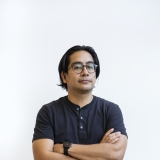
Ronny Quevedo
Ronny Quevedo (b.1981) was born in Guayaquil, Ecuador, and lives and works in the Bronx, NY. Quevedo’s practice spans installation, drawings, and prints, incorporating and subverting aspects of abstraction, painting, collage, cartography, and sports imagery. Deeply engaged with notions of identity and the intersection of mainstream and historically marginalized cultures, Quevedo reenvisions pre- and post-colonial iconographies, offering nuanced examinations of personal and social histories. This recuperation of indigenous languages of abstraction, the revalorization of their associated labor, and the centering of a living connection between contemporary and centuries-old cultural markers remain key to Quevedo’s ongoing practice.
From the materials he uses to the themes he explores, Quevedo’s work is rooted in an exploration of his history and identity, initially using his art as a way to understand the lives and experiences of his parents. Quevedo’s father was a professional soccer player in Ecuador and the artist often incorporates the reconstructed and reorganized lines of athletic fields in his work. Similarly, the influence of Quevedo’s mother’s work as a dressmaker is evidenced in his incorporation of mediums like muslin and wax tracing paper. “To me,” says Quevedo, “there is no division of significance; these humble technical materials can be imaginatively and resourcefully transformed. My family history, which contained lots of adaptation, embodies this capacity for transformation.” By contextualizing these materials with ostensibly precious materials like gold and silver leaf, Quevedo invites the viewer to interrogate the simultaneous valuation of certain luxuries and erasure of the artisans who create them.
Beyond contributing to the formal, material, and conceptual elements of his practice, Quevedo’s family histories serve as prompts to consider the political and social implications of how bodies, or groups of bodies, exist and operate in space. “My visual language incorporates topographies that echo the strategies of path finding utilized by migrants. The movement of bodies, like those of constellations, posit geography, and space as liminal positions, like players in space.” Through his employment of lines, grids, and diagrammatic visuals, Quevedo’s works take on a cartographic quality that not only explores the complex intersections between the personal and the cultural but also offers the possibility of reimagining and reconfiguring geographic and historical positions.
Central to Quevedo’s practice is the incorporation of and reverence for the cultural heritage of the Americas. For Quevedo, pre-Columbian history “is associated with having been conquered and, thus, a sense that its culture exists in a past that is extinct... When I reference Inca or Wari culture in my work, I’m looking into a cultural space and approach whose legacy continues to be influential. This is a conscious decision to resist contemporary notions of minimalism and abstraction as political and symbolic. Indigenous South American cultures developed their visual language of abstraction, one that points to a lineage of thought that exists outside of the figurative and the textual, in ways not traditionally acknowledged in the Western art-historical canon.”
Expanding on the histories and possibilities of textiles and papermaking, works such as myself when I am real - sin ti soy nadie (2021) are imbued with an added dimension: a sculptural approach that emphasizes the presence of the physical body. The result of a meticulous process that involves cutting slivers of pattern paper, reassembling them into abstract compositions, and fusing their surface together with gold leaf on muslin, myself when i am real... is designed to be doubled over and hung in the exhibition space, so that viewers can interact with both its aesthetically refined surface and its three-dimensional presence. The incorporation of muslin and the positioning as a draped object emphasizes the work’s material and conceptual connection to the living legacy of South American textiles, indicating the artist’s increasingly complex and sophisticated elaboration on his core themes.
Ronny Quevedo’s work will be featured in upcoming solo and group presentations at Krannert Art Museum, University of Illinois Urbana-Champaign; The Menil Collection, Houston, TX; and San Francisco Museum of Modern Art, CA. In 2022, he was commissioned by Delta Air Lines in partnership with the Queens Museum to create a large-scale permanent installation at LaGuardia Airport, Queens, NY. Quevedo’s work has been the subject of numerous solo presentations, including Ronny Quevedo: ule ole allez, Locust Projects, Miami, FL (2022); Ronny Quevedo: offside, University Art Museum, University of Albany, NY (2022); and no hay medio tiempo / there is no halftime, Queens Museum, NY (2017), traveled to Temple Contemporary, Tyler School of Art and Architecture, Philadelphia, PA (2019), among others. Quevedo has participated in many group exhibitions, including El Dorado: Myths of Gold, Americas Society/Council of the Americans, New York, NY (2023); Gilded: Contemporary Artists Explore Value and Worth, Weatherspoon Art Museum, University of North Carolina at Greensboro, NC (2022), traveled to Hunter Museum of American Art, Chattanooga, TN (2023), and Hood Museum of Art, Dartmouth, Hanover, NH (2024); Pacha, Llacta, Wasichay; Indigenous Space, Modern Architecture, New Art, Whitney Museum of American Art, New York (2018); and The World’s Game: Fútbol and Contemporary Art, Pérez Art Museum, Miami, FL (2018). Quevedo’s work is in the collections of the Buffalo AKG Art Museum, NY; Colorado Springs Fine Arts Center at Colorado College, CO; Denver Art Museum, CO; and Whitney Museum of American Art, New York, NY, among others. He is the recipient of many awards and grants, including the Joan Mitchell Fellowship (2021); Jerome Hill Artists Fellowship (2019); Socrates Sculpture Park Artist Fellowship (2017); Queens Museum / Jerome Foundation Fellowship for Emerging Artists (2016), and others.






